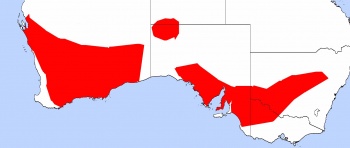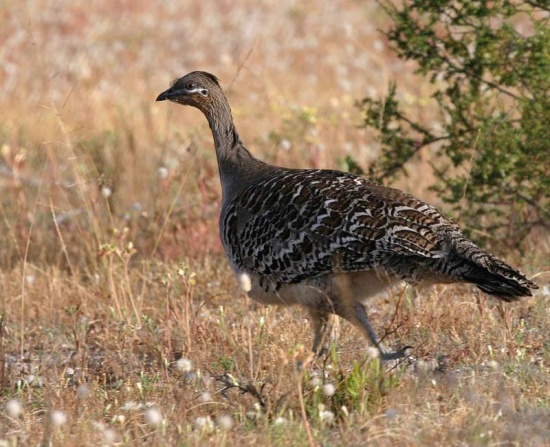|
|
| (11 intermediate revisions by 10 users not shown) |
| Line 1: |
Line 1: |
| − | ;Leipoa ocellata
| + | [[Image:Malleefowl.jpg|thumb|550px|right|Photo © by {{user|Pearly+shells|Pearly shells}}<br /> Innes National Park, [[South Australia]], 24th November 2003]] |
| − | [[Image:Malleefowl.jpg|thumb|550px|right|Photo by Pearly shells]] | + | '''Alternative names: Lowan, Malleehen''' |
| | + | ;[[:Category:Leipoa|Leipoa]] ocellata |
| | ==Identification== | | ==Identification== |
| − | The Malleefowl (Leipoa ocellata) is a stocky ground-dwelling Australian bird about the size of a domestic chicken (to which it is distantly related).
| + | 55-61cm |
| | + | *Quite large |
| | + | *Grey head and neck |
| | + | *Black line down neck |
| | + | *Upper-parts mottled grey, white, black, chestnut and buff |
| | ==Distribution== | | ==Distribution== |
| − | It is now reduced to three separate populations: the Murray-Murrumbidgee basin, west of Spencer Gulf along the fringes of the Simpson Desert, and the semi-arid fringe of Western Australia's fertile south-west corner.
| + | [[Image:Malleefowl2.jpg|thumb|350px|right|Graphic by {{user|Nrg800|Nrg800}}]] |
| | + | [[Australia]].<br /> |
| | + | Patchy though the Mallee areas of southern [[New South Wales]], northwest [[Victoria]] and Little Desert to Murry river Basin. Small patches of population in mallee areas of [[South Australia]] and southwest [[Northern Territory]]. |
| | + | |
| | ==Taxonomy== | | ==Taxonomy== |
| − | | + | This is a [[Dictionary_M-S#M|monotypic]] species<sup>[[#References|[1]]]</sup>. |
| | ==Habitat== | | ==Habitat== |
| − | It occupies semi-arid mallee scrub on the fringes of the relatively fertile areas of southern Australia.
| + | Unburnt mallee or woodland with lots of leaf litter and low scrub |
| | ==Behaviour== | | ==Behaviour== |
| − | Malleefowl are shy, wary, solitary birds that usually fly only to escape danger or reach a tree to roost in. Although very active, they are seldom seen as they freeze if disturbed, relying on their intricately patterned plumage to render them invisible, or else fade silently and rapidly into the undergrowth (flying away only if surprised or chased).
| + | *Moves around in singles or pairs |
| − |
| + | *Forages in scrub and grain stubble |
| − | Pairs occupy a territory but usually roost and feed apart: their social behavior is sufficient to allow regular mating during the season and little else.
| + | *When wary 'freezes', then slowly moves away, or flys up tree, with heavy flapping |
| − | | + | *Dust-bathes, rests and basks in deep shade |
| − | In winter, the male selects an area of ground, usually a small open space between the stunted trees of the mallee, and scrapes a depression about three metres across and just under a metre deep in the sandy soil by raking backwards with his feet. In late winter and early spring, he begins to collect organic material to fill it with, scraping sticks, leaves and bark into wind-rows for up to 50 metres around the hole, and building it into a nest-mound, which usually rises to about 0.6m above ground level. The amount of litter in the mound varies, it may be almost entirely organic material, mostly sand, or anywhere in between.
| + | *Roosts on low branch |
| − | | + | *Forages in leaf litter |
| − | After rain, he turns and mixes the material to encourage decay and, if conditions allow, digs an egg chamber in August (the last month of the southern winter). The female sometimes assists with the excavation of the egg chamber, and the timing varies with temperature and rainfall. The female usually lays between September and February, provided there has been enough rain to start organic decay of the litter. The male continues to maintain the nest-mound, gradually adding more soil to the mix as the summer approaches (presumably to regulate the temperature).
| + | ===Breeding=== |
| − | | + | The male makes the nest by scraping a large depression in sandy soil. He fills it with sticks, leaves and bark, making a mound. He mixes the material to decay it and then digs an egg chamber. He adds more soil to the mound once the eggs have been laid. Usually 15 eggs are laid at weekly intervals. Incubation takes between 50 and 100 days dependent on temperature. Chicks hatch one at a time and scratch their way to the surface of the mound. They are independent from the start. |
| − | | |
| − | Malleefowl moundMales usually build their first mound (or take over an existing one) in their fourth year, but tend not to achieve as impressive a structure as older birds. They are thought to mate for life, and although the male stays nearby to defend the nest for nine months of the year, they can wander at other times, not always returning to the same territory afterwards.
| |
| − | | |
| − | The female lays a clutch of anywhere from two or three to over 30 large, thin-shelled eggs, mostly about 15; usually about a week apart. Each egg weighs about 10% of the female's body weight, and over a season it is common for her to lay 250% of her own weight. Clutch size varies greatly between birds and with rainfall. Incubation time depends on temperature and can be anywhere between about 50 and almost 100 days.
| |
| − | | |
| − | Hatchlings use their strong feet to break out of the egg, then lie on their backs and scratch their way to the surface, struggling hard for five or ten minutes to gain 3 to 15cm at a time, and then resting for an hour or so before starting again. Reaching the surface takes between 2 and 15 hours. Chicks pop out of the nesting material with little or no warning with, eyes and beaks tightly closed, then immediately take a deep breath and open their eyes, before freezing motionless for as long as 20 minutes.
| |
| − | | |
| − | | |
| − | Cross section of a Malleefowl mound, showing layer of sand (up to 1 m thick) used for insulation; egg chamber; and layer of rotting compost. The egg chamber is kept at a constant 33°C by opening and closing air vents in the insulation layer, while heat comes from the compost below.The chick then quickly emerges from out of the hole and rolls or staggers to the base of the mound, disappearing into the scrub within moments. Within an hour it will be able to run reasonably well; it can flutter for a short distance and run very fast within two hours, and despite not having yet grown tail feathers, it can fly strongly within a day.
| |
| − | | |
| − | Chicks have no contact with adults or other chicks: they tend to hatch one at a time and birds of any age ignore one another except for mating or territorial disputes.
| |
| − | | |
| − | The Malleefowl is classified as endangered. Predation from the introduced red fox is a factor, but the critical issues are changed fire regimes and the ongoing destruction and fragmentation of habitat. Like the Southern Hairy-nose Wombat it is particularly vulnerable to the increasing frequency and severity of drought that has resulted from climate change.
| |
| − | | |
| − | | |
| | | | |
| | + | ===Voice=== |
| | + | The male emits two deep, bellowing notes or booms with the female speaking in high pitched crows, soft crooning and low grunts. |
| | + | ==References== |
| | + | #{{Ref-Clements6thOct22}}#Pizzey, G. & Knight, F. 1997. Birds of Australia (Collins Field Guide). HarperCollins Publishers, London. ISBN 0-00-220132-1 |
| | ==External Links== | | ==External Links== |
| − | {{GSearch|Leipoa+ocellata}} | + | {{GSearch|"Leipoa ocellata" {{!}} "Malleefowl" {{!}} "Lowan" {{!}} "Malleehen"}} |
| − | *[http://www.aviceda.org/abid/birdimages.php?action=birdspecies&fid=4&bid=22 View more images of this species on the ABID]
| + | {{GS-checked}}1 |
| | + | <br /> |
| | + | <br /> |
| | | | |
| − | [[Category:Birds]] | + | [[Category:Birds]][[Category:Leipoa]][[Category:Maps]] |
Alternative names: Lowan, Malleehen
- Leipoa ocellata
Identification
55-61cm
- Quite large
- Grey head and neck
- Black line down neck
- Upper-parts mottled grey, white, black, chestnut and buff
Distribution
Australia.
Patchy though the Mallee areas of southern New South Wales, northwest Victoria and Little Desert to Murry river Basin. Small patches of population in mallee areas of South Australia and southwest Northern Territory.
Taxonomy
This is a monotypic species[1].
Habitat
Unburnt mallee or woodland with lots of leaf litter and low scrub
Behaviour
- Moves around in singles or pairs
- Forages in scrub and grain stubble
- When wary 'freezes', then slowly moves away, or flys up tree, with heavy flapping
- Dust-bathes, rests and basks in deep shade
- Roosts on low branch
- Forages in leaf litter
Breeding
The male makes the nest by scraping a large depression in sandy soil. He fills it with sticks, leaves and bark, making a mound. He mixes the material to decay it and then digs an egg chamber. He adds more soil to the mound once the eggs have been laid. Usually 15 eggs are laid at weekly intervals. Incubation takes between 50 and 100 days dependent on temperature. Chicks hatch one at a time and scratch their way to the surface of the mound. They are independent from the start.
Voice
The male emits two deep, bellowing notes or booms with the female speaking in high pitched crows, soft crooning and low grunts.
References
- Clements, J. F., T. S. Schulenberg, M. J. Iliff, T. A. Fredericks, J. A. Gerbracht, D. Lepage, S. M. Billerman, B. L. Sullivan, and C. L. Wood. 2022. The eBird/Clements checklist of Birds of the World: v2022. Downloaded from https://www.birds.cornell.edu/clementschecklist/download/
- Pizzey, G. & Knight, F. 1997. Birds of Australia (Collins Field Guide). HarperCollins Publishers, London. ISBN 0-00-220132-1
External Links
GSearch checked for 2020 platform.1





